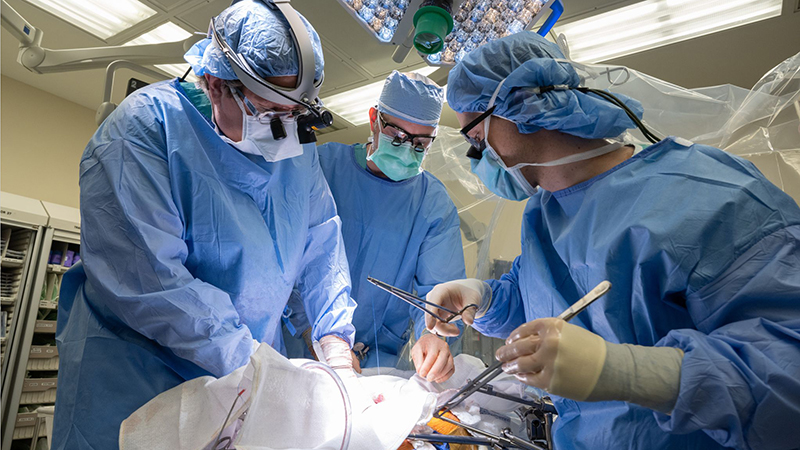California Physician Receives First Double-Lung and Liver Transplant for Advanced Lung Cancer in the U.S.
Santa Monica Pulmonologist Gary Gibbon, MD, Traveled to Chicago for a First-of-Its-Kind Transplant
Updated October 2025
As a pulmonologist, 69-year-old Gary Gibbon, MD, from Santa Monica, California, has dedicated his career to taking care of other people's lungs. In March 2023, he was shocked to discover his lungs needed help when he was diagnosed with stage 3 lung cancer. He had limited time to live.
He'd end up being the first person in the U.S. to receive a double-lung and liver transplant for advanced lung cancer at Northwestern Medicine.
After undergoing chemotherapy, radiation and immunotherapy at a California hospital, Dr. Gibbon was admitted to the intensive care unit (ICU), where he learned the immunotherapy had not only permanently destroyed his lungs, but also caused irreparable damage to his liver. His only option for survival would be traveling to Northwestern Memorial Hospital for a combined double-lung and liver transplant, where a first-of-its-kind clinical program called Double Lung Replacement and Multidisciplinary Care (DREAM) was established for select patients with advanced lung cancers that do not respond to conventional treatments.
In September 2023, Dr. Gibbon received his new lungs and liver from the same donor, and six months after surgery, Dr. Gibbon still has no signs of cancer in his body and doesn't require any further cancer therapy.
As a physician, I knew I was in the right place.— Gary Gibbon, MD
"To our knowledge, this is the first known case in the nation where a patient with advanced lung cancer has successfully received a combined lung-liver transplant," says Ankit Bharat, MD, chief of Thoracic Surgery and director of Northwestern Medicine Canning Thoracic Institute, who performed Dr. Gibbon's lung transplant. "In Dr. Gibbon's case, he received all possible treatments for his aggressive lung cancer. Unfortunately, not only did his cancer not get treated, but he also developed severe damage to his lungs and liver that was unsustainable with life. He was running out of time, and the DREAM program was his only option for survival."
A Pulmonologist Battling Lung Cancer — and Liver Failure
In March 2023, Dr. Gibbon started coughing and losing weight. A chest X-ray confirmed a mass with a diagnosis of stage 3 lung cancer. He proceeded with chemotherapy, immunotherapy and radiation. By mid-July, he was hospitalized with septic shock, pneumonia and multiple organ failure. His lungs had thickened with scar tissue due to the cancer treatment, and he was fighting for his life in a Los Angeles ICU.
"As a pulmonologist, I never imagined I'd ever need a lung transplant — let alone for lung cancer," says Dr. Gibbon. "While my doctors in California had done everything they could, we knew there was only one place in the entire country that could give me a fighting chance."
Unfortunately, Dr. Gibbon wasn't just up against lung cancer.
"Dr. Gibbon met the criteria to receive a double-lung transplant through our DREAM program, but as the preliminary evaluation was performed prior to his acceptance to Northwestern Medicine, our team discovered that he had also developed liver cirrhosis from the immunotherapy," says Dr. Bharat. "We had to modify our DREAM program and work with Satish Nadig, MD, PhD, a transplant surgeon and director of Northwestern Medicine Comprehensive Transplant Center, and his team to formulate a pathway for Dr. Gibbon to receive not only a double-lung transplant, but a concurrent liver transplant."
An Innovative, Lifesaving Procedure
On September 10, Dr. Gibbon was transported to Chicago via a four-hour medical flight and waited for new organs from his ICU bed at Northwestern Memorial Hospital. After spending 12 days on the transplant waitlist, Dr. Gibbon received his new lungs shortly before midnight on September 26, and his new liver in the early hours on September 27.
Dr. Bharat and Dr. Nadig worked together during the 10-hour procedure. While the new lungs were put in first, the donor liver was kept alive outside the body thanks to new technology called liver perfusion — or "liver in a box." The liver was attached to a machine that pumps warm, oxygenated and nutrient-enriched blood through the organ. When the liver was on the pump, the team could assess its function to ensure it was ideal for transplantation. The liver perfusion technology also gave Dr. Bharat enough time to meticulously remove the damaged lungs and all the cancer. Using lessons learned from pioneering COVID-19 lung transplantation in the United States, Dr. Bharat's team developed the novel surgical technique to clear the cancer during surgery while minimizing the risk of spread.
This technique involves:
- Putting patients on full heart and lung bypass
- Carefully taking the cancer-ridden lungs out
- Removing the associated lymph nodes
- Washing the airways and chest cavity to clear the cancer
- Putting in the new donor lungs
"These patients can have billions of cancer cells in the lungs, so we must be extremely meticulous to not let a single cell spill into the patient's chest cavity or blood stream," says Dr. Bharat. "We believe this technique can help reduce the risk of recurrence, which we learned through our experience with pioneering COVID-19 lung transplants."
Life After Double-Lung and Liver Transplant
Six months after surgery, Dr. Gibbon still has no signs of cancer in his body and doesn't require any further cancer therapy. "As a physician, I knew I was in the right place. I wasn't just stepping on the moon by myself. It took surgeons, oncologists, transplant specialists, nurses, respiratory therapists and most importantly, my donor, to help me get my 'Triple L' — two lungs and a liver," says Dr. Gibbon. "This DREAM program is new territory for transplantation, and the fact that I could experience it and have a wonderful outcome makes me feel so blessed. I wouldn't be here today without Northwestern Medicine."







